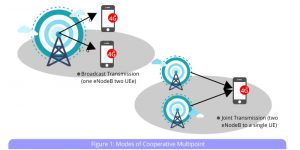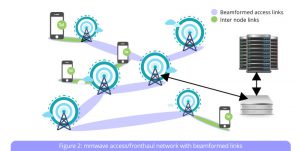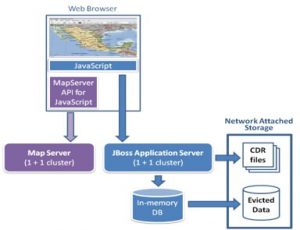The 5th generation cellular networks have set an explicit target to improve the performance of cell-edge users. This is widely acknowledged in the industry as being a challenge; multiple studies [ (1), (2)] have modelled cell-edge channels and UE performance in representative modern cellular systems. It is known that there are multiple factors involved; these include higher path loss, non uniform power distribution by the primary network node, interference from neighbouring nodes, lack of diversity in paths, etc.
Starting at least from the days of GSM, there has been much research in augmenting cell-edge performance. Whereas larger GSM cells were limited by timing synchronization conditions, it was identified fairly early on that small cells were limited by cross-cell interference, specifically CCI. The problem became acute with the advent of 3G networks and the increasing use of the cellular network to carry data.
Adaptive channel management was introduced in GPRS and enhanced in E-GPRS; while not specifically targetted to cell-edge performance, it nevertheless allowed improved performance for cell-edge users automatically, by adapting the channel to interference and other related impairments. Adaptive Channel Management requires significant changes in the air interface, requiring dedicated feedback channels. Nevertheless it was successful enough so as to take over as the main tool for channel adaptation. In fact, UMTS, which was first to be governed by a double loop power control mechanism was upgraded to HSDPA by adding, among other things, adaptive coding and modulation.
ACM works primarily by trading off resources for bandwidth, or bandwidth for integrity; for example, if the downlink is converted from a QAM modulation to a QPSK modulation, we either need to allocate twice the resources to this channel (in order to maintain bit-rate) or will sacrifice bit-rate in order to maintain accuracy. ACM is also limited by the feedback rate and cannot react to sudden changes to link condition.
In recent times, one of the paths most pursued has been in cooperative network action. The idea behind this is to combine the efforts of multiple network nodes; those in close proximity to the UE, to cooperate so as to improve the channel. The cooperating nodes have to include both the primary cell which is currently servicing the UE as well as other adjacent nodes. The degree of cooperation can range from passive (interference mitigation) to active coordination . An early example of this is soft and softer handover in HSPA systems, which are an early example of macro-diversity; multiple network nodes (nodeBs) listen to the same channel and combine their signals so as to get a better performance. In the WiMAX standard, there was an attempt to handle this using macro-diversity, which required multiple base-stations to cooperatively transmit to and receive from a single UE. However, cooperation of this manner requires extensive communication between network nodes and a degree of timing synchronization (depending on the specific radio technology being used, cooperating network nodes may need to be synchronized to within 1 ms to 1s).
With the advent of 3.5G and 4G, there has been some interest in small-cells and femto-cells; one of the application scenarios is the opportunistic use of small cells/pico-cells to augment coverage in places where the cell-sizes are relatively large. This is shown in the figure below. The principal challenge of using small-cells for opportunistic coverage remains the inter-cell coordination problem.
Nevertheless, small-cells remain an exciting possibility for closing the coverage problem. To support small-cell/macro-cell co-existence, 3gPP has introduced features such as Inter-Cell Interference Coordination (further enhanced to eICIC and feICIC). ICIC creates transmission opportunities by small-cells operating in proximity of a macro-cell, by introducing silent or reduced power slots for the macro-cell.
The most recent development in this area is that of coordinated multipoint or CoMP. CoMP allows inter-node active cooperation in the broadest sense; ranging from joint scheduling to more advanced techniques such as jointly encoded broadcast transmission. Extensive research has been carried out in this area, especially in the areas of joint encoding and transmission. In (3), we have proposed a mechanism called Active null Forming (AnF) which allows network nodes to cooperatively transmit to a group of UEs, with joint encoding ensuring that each network node minimizes the interference to UEs other than the one it is transmitting with, as shown in the following image.
 Figure 1: Modes of Cooperative Multipoint
Figure 1: Modes of Cooperative Multipoint
With the advent of distributed antennae systems (DAS) and Remote Radio Heads (RRH), connected by low-latency high bandwidth optical/mmwave links, CoMP techniques are increasingly feasible. With distributed paths, they also take care of the Achilles Heel of modern MIMO transmission; the fact that rank of a transceiver pair rarely exceeds 2.
Finally, we have dynamic beam-forming (by which term we refer to the coherent shaping of beams in a specific direction, as opposed to the de-coherence in MIMO), which has been a technology which has been around for a long time, but has yet to be realized. Beam-forming requires multiple antenna elements close enough to provide a coherent combined beam; application of shaped beams have an especially benefit for cell-edge performance, because it can concentrate the power of the network precisely on the UE. While static beam-shaping by the use of sectoral antenna is widespread, dynamic beam-forming has been relatively slow to take off in the cellular world. This may, however, change very soon. LTE Advanced incorporates air interface features which allows dynamic beam-forming. And with the advent of mm-wave in the fronthaul and access networks, beamforming will go from being an optional enhancement to a necessity.
 Figure 2 mmwave access/fronthaul network with beamformed links
Figure 2 mmwave access/fronthaul network with beamformed links
While the 5th generation cellular network is still being defined, there are some trends which are probably going to play a large role in the architecture of these networks. The key drivers can be summarized as follows:
The idea of a cloud RAN, where expensive baseband processing is done at a centralized location is gaining increasing traction; thanks to high-speed low latency ‘fronthaul’ links, it is increasingly possible to split the network side stack lower and lower down. The latest proposals call for a split –PHY architecture, where basic symbol recovery is done at the radio-head and the remaining baseband processing, including channel estimation, precoding, FEC decoding/encoding, etc. are all done in the backend. The principal driver for this is cost-savings; by centralizing the digital hardware, operators save on capex costs, while being able to deploy more and more towers (necessitated by the movement to higher frequency spectrum)
A second key driver is likely the idea of replacing a monolithic RAN by a multitude of nodes, each of which has a limited set of functions (4). This is a trend co-resident with the idea of a cloud RAN and also with the increasing interest in Software Defined Networking. As currently envisioned, the RAN functions are separated into synchronization, system information broadcast, paging, unicast data transfer and multicast data transfer; further sub-divisions are possible as the idea evolves. By having standardized radio heads which can be dynamically reconfigured to play a variety of roles, the system can deploy resources where needed based on traffic feedback. This envisions that the existing ‘cell’ based architecture be redeployed as a ‘hyper-cellular’ architecture.
Finally, we have the trend of Cooperative (5)and Multi-user DAS (6) which will bring out the full possibilities of MIMO. The network of dense DAS will be optimized by a network wide SON solution, utilizing feedback from all points simultaneously to maximize performance for minimum resource utilization. Some of the antenna systems will operate in pure slave mode, simply to add additional paths for a better MIMO performance, or as envisioned in our paper to act as interference cancelling points. To make this possible, the DAS will be connected by a high-bandwidth microwave or optimal fiber ‘fronthaul’ backbone and will share channel information and signal conditions on a millisecond by milli second basis.
Figure 3 shows a view of the hypothesized network architecture, incorporating the cloud RAN, the split functionality and the cooperative MIMO components.

Figure 3: Hypothetical 5G Architecture
This network architecture, if realized, will be able to improve cell-edge performance in multiple ways.
5th Generation networks will have to incorporate radical changes in signal processing technology and network architecture in order to meet the ambitious targets set to them in terms of coverage and throughput. Associated business objectives such as cost rationalization, usage of higher frequency spectrum and energy efficiency will also have to be addressed. Some of the possible technologies have been discussed here, in the context of the architectural changes required to support them.
Cell Edge Performance of Cellular Mobile Systems. You, Xiaoho and Wang, Dongming and Zhu, Pengcheng and Sheng,Bin. 6, New York : IEEE, June 2011, Selected Areas of Communication, IEEE Journal on, Vol. 29. 0733-8716.
Enhancing Cell-Edge Performance: A Downlink Dynamic Interference Avoidance Scheme with Inter-Cell Coordination. Yanikomeroglu, Mahmudur Rahman and Halim. 4, NY : IEEE, 2010, Wireless Communications; IEEE Transactions on, Vol. 9. ISSN 1536-1276.
Saha, Abheek. A Novel Technique for Cross-Cell Interference Mitigation using Joint Encoding. www.hsc.com. [Online] October 2015.
Software-Defined Hyper-Cellular Architecture for Green and Elastic Wireless Access. Sheng Zhou, Tao Zhao, Zhisheng Niu, and Shidong Zhou. 1, NY : IEEE Communications Society, January 2016, IEEE Communications Magazine, Vol. 54, pp. 12–19. ISSN 0163-6804.
Cooperative Distributed Antenna Systems for Mobile Communications. Xiao-Hu You, Dong-Ming Wang, Bin Sheng, Xi-Qi Gao, Xin-Sheng Zhao and Ming Chen. 3, NY : IEEE, 2010, IEEE Wireless Communications, Vol. 17, pp. 35-43.
Radio Resource Allocation in Multiuser Distributed Antenna Systems. Zhu, Huiling and Wang, Jiangzhou. 10, s.l. : IEEE, 2013, IEEE Journal on Selected Areas of Communication, Vol. 31.